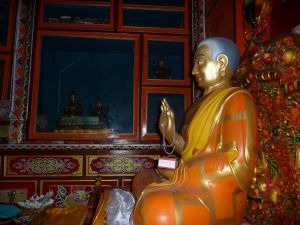Dhāraṇī - 3
Dharanis (Devanagari: धारणी, IAST: dhāraṇī), also known as a Parittas, are Buddhist chants, mnemonic codes, incantations, or recitations, usually the mantras consisting of Sanskrit or Pali phrases. Believed to be protective and with powers to generate merit for the Buddhist devotee, they constitute a major part of historic Buddhist literature.
Many of these chants are in Sanskrit and Pali, written in scripts such as Siddham as well as transliterated into Chinese, Korean, Japanese, Sinhala, Thai and other regional scripts. Dharanis are found in the ancient texts of all major traditions of Buddhism.
They are a major part of the Pali canon preserved by the Theravada tradition. Mahayana sutras – such as the Lotus Sutra and the Heart Sutra – include or conclude with dharani.
Some Buddhist texts, such as Pancaraksa found in the homes of many Buddhist tantra tradition followers, are entirely dedicated to dharani. They are a part of the regular ritual prayers as well as considered to be an amulet and charm in themselves, whose recitation believed to allay bad luck, diseases or other calamity.
They were an essential part of the monastic training in Buddhism's history in East Asia. In some Buddhist regions, they served as texts upon which the Buddhist witness would swear to tell the truth.
The dharani-genre of literature became popular in East Asia in the 1st millennium CE, with Chinese records suggesting their profusion by the early centuries of the common era. These migrated from China to Korea and Japan. The demand for printed dharani among the Buddhist lay devotees may have led to the development of textual printing innovations.
The dharani records of East Asia are the oldest known "authenticated printed texts in the world", state Robert Sewell and other scholars. The early-8th-century dharani texts discovered in the Pulguksa temple of Gyeongju, Korea are considered as the oldest known printed texts in the world.
Dharani recitation for the purposes of healing and protection is referred to as Paritta in some Buddhist regions, particularly in Theravada communities.
The dharani-genre ideas also inspired Buddhist chanting practices such as the Nianfo (Chinese: 念佛; Pinyin: niànfó; Romanji: nenbutsu; RR: yeombul; Vietnamese: niệm Phật), the Daimoku, as well as the Koshiki texts in Japan.
They are a significant part of the historic Chinese dazangjing (scriptures of the great repository) and the Korean daejanggyeong – the East Asian compilations of the Buddhist canon between the 5th and 10th centuries. (en)
Source
[[1]]
